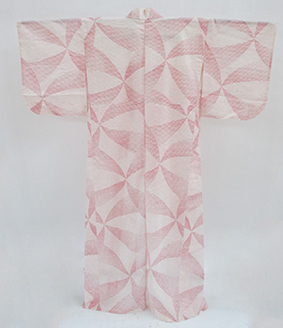The yukata pictured below in figures one and two dates from the late twentieth century. It is red and white, although it appears pink, and was made from cotton for a young woman. The sleeves are not very long and it is lined at the top of the back. The yukata is, in many ways, deeply connected to traditional Japanese culture yet is it consistently defined as a causal garment.
Figure 1: Front |
Figure 2: Back |
 |
 |
This garment is machine made, which is fitting for the time when it became more common for garments such as this one to be manufactured by machine. Although the quality might not be comparable to one that is hand-stitched with more care, it is very typical of the time.
Cotton is especially important because that is the fabric used most often for a yukata. Cotton is airy, breathable, and cooling for hot and humid environments. Traditionally, the yukata was put on directly after a bath in steamy water and has evolved over time to be worn during the hot summers in Japan, according to many sources.
The red and white pinwheel pattern, which can be seen below in Figure 3, is youthful. Younger women typically wear brighter colors and patterns, as opposed to older women who may choose a more modest, darker color to express their maturity. These colors represent the summer heat, a time of celebration. White threads are intermixed with the red threads to give the illusion of pink. Pink is another summer, vibrant color, and white is another flower color that would be seen in nature during that season.
Figure 3: Pattern Detail |
 |
© Savannah Norris, 2020

